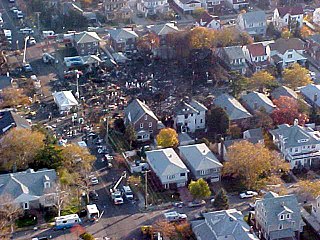American Airlines Flight 587
November 2001 aviation accident in New York, US From Wikipedia, the free encyclopedia
Remove ads
American Airlines Flight 587 was a scheduled commercial flight from John F. Kennedy International Airport in New York City to Las Américas International Airport in the Dominican Republic. The aircraft was a Airbus A300-600. On November 12, 2001, the aircraft crashed into the Belle Harbor neighborhood of Queens, New York, killing all 260 people on board plus 5 people on the ground.[1] The crash was caused by the failure of the plane's tail because of pilot error in wake turbulence (turbulence that forms behind an airplane as it flies through the air).[2] It is the second-deadliest plane crash in the United States after American Airlines Flight 191, which occurred on May 25, 1979.
Remove ads

Since the accident took place two months and one day after the September 11 attacks on the World Trade Center in Manhattan, it led people to believe that the crash was caused by terrorism.[3]
Remove ads
Aircraft and Victims
American Airlines Flight 587, an Airbus A300B4-605R registration (N14053) was piloted by Captain Edward States, (42) and First Officer Sten Molin, (34). The First Officer was flying the plane. Most of the passengers on-board (159) were Americans, but 68 were Dominicans as well, there were also five Indonesians, three Taiwanese, two Canadians, two Australians, two Brazilians, one French, one German, one Haitian, one Italian, one Japanese, one Dutch, one Israeli, one Mexican, one British, and one Swiss passenger on board.
Remove ads
Accident
Flight 587 was scheduled to leave John F Kennedy at 08:00 for a flight to Santo Domingo, Dominican Republic. The boarding process at gate 22 took a little longer than planned due to additional security procedures that delayed boarding. The gate was closed at 08:38 and push-back from the gate was accomplished at 9:00. The crew taxied to runway 31L behind Japan Airlines Flight 047, a Boeing 747-400 bound for Tokyo, Narita, that was cleared for takeoff at 9:11am. As the 747 climbed, the tower contacted Flight 587’s pilots and warned them about potential wake turbulence from the 747.
At 9:13:28 Flight 587 was cleared for takeoff from Runway 31L. The aircraft left the runway at 9:14:29, about 1 minute and 40 seconds after the JAL flight. From takeoff, the plane climbed to an altitude of 500 ft and then entered a climbing left turn to heading of 220. At 9:15:00, the pilot made initial contact with the departure controller informing him that the airplane was at 1,300 ft and climbing to 5,000 ft. The departure controller instructed the aircraft to maintain 13,000 ft.
At 9:15:36, the aircraft hit wake turbulence from the JAL flight just in front of it. The first officer attempted to stabilise the aircraft with alternating aggressive rudder inputs from left to right. This continued for at least 20 seconds, until 9:15:56, when the stress of the first officer’s repeated rudder movements caused the lugs that attached the vertical stabilizer and rudder to break. The stabilizer separated from the aircraft and fell into Jamaica Bay, about one mile north of the main wreckage site.
Eight seconds later, the stall warning sounded on the cockpit voice recorder. At the moment the stabilizer separated from the aircraft the plane pitched downwards. As the pilots struggled to control the aircraft, it went into a flat spin. The resulting aerodynamic loads sheared both engines from the aircraft seconds before impact. The engines landed several blocks north and east of the main wreckage site. Losing the engines cut off power to the flight data recorder at 9:16:00, while the cockpit voice recorder cut off at 9:16:15, moments before impact.
The fuselage slams into the ground in Belle Harbor on Newport Avenue and Beach 131st Street, instantly destroying three houses, killing everyone on board plus five people on the ground and one person on the ground was injured and the impact forces and post-crash fire destroyed the wreckage.
Remove ads
Investigation
The investigation into the crash was led by the National Transportation Safety Board (NTSB).
They decided that the probable cause of the in-flight separation of the vertical stabilizer was the result of the loads beyond ultimate design that were created by the first officer’s unnecessary and excessive rudder pedal inputs. Contributing to these rudder pedal inputs were characteristics of the A300-600 rudder system design and elements of the American Airlines Aircraft Manoeuvring Program.
References
Other websites
Wikiwand - on
Seamless Wikipedia browsing. On steroids.
Remove ads

